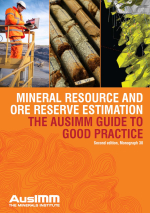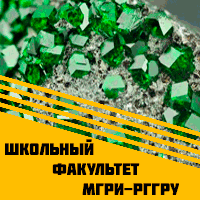Добрый день, Коллеги. Важное сообщение, просьба принять участие. Музей Ферсмана ищет помощь для реставрационных работ в помещении. Подробности по ссылке
Mineral resource and ore reserve estimation. The AusIMM guide to good practice / Оценка минеральных ресурсов и запасов руды — путеводитель AusIMM по лучшим практикам
Chapter 1 | An Overview and Outline
Overview
Managing Risk in Feasibility Studies
Common Sense and Good Communication – Effective Team-Based estimation and classification of mineral resources and ore reserves
JORC and the Canadian Institute of Mining, Metallurgy and Petroleum definition standards – major changes and developments for Competent Person
Chapter 2. The resource database
Overview – The Resource Database
Design principles of relational databases and management of data Flow for Resource Estimation
Sampling and analysis protocols and their role in mineral exploration and new development
Geological Data Collection for Reliable Coal Resource Estimation
A review of the reliability and validity of portable X-Ray fluorescence spectrometry (pXRF) data
How sampling biases can induce decision-makers to make wrong decisions – an introduction to qualitative sampling theory
Practical considerations and shortcuts in sampling
Geostatistical criteria for choosing an optimal ratio between quality and quantity of samples – method and case studies
Measurement of Bulk Density for Resource Estimation – Methods, guidelines and quality control
Collection of Geotechnical Data from Drill Holes
Use and abuse of oriental drill core
Chapter 3.Geological interpretation and geological modeling
Overview – geological interpretation and geological modeling
Geological interpretation for resource modeling and estimation
Best practice in coal exploration and resource evaluation
The Do’s and Don’ts of Geological and Grade Boundary Models and what you can do about it
A checklist for grade control
Calculated mineralogy and its applications
X-Ray plunge projection – understanding structural geology from Grade Data
Practical implicit dyke modeling for resource estimation – Newmont Boddington gold, Western Australia
The Pursuit of Best Practice and Use of Innovative Techniques – Case studies in geological interpretation and modelling, gold fields – growth and international projects
Wireframe-free geological modelling – an oxymoron or a value proposition?
Chapter 4. Mineral resource estimation
Overview – Mineral Resource Estimation
Mineral resource estimation of the Brockman 4 iron deposit in the Pilbara Region by Rio Tinto Iron Ore
Multivariable iron ore deposit resource estimation – a practitioner’s guide to selecting methods
Tropicana gold mine, Western Australia – a case study of non-linear mineral resource estimation Estimation of Underground Mineral Resources at the Sunrise Dam gold mine – a case study in risk management
Mineral sands – some aspects of evaluation, resource estimation and reporting
A practitioner’s guide to the indentification, classification an Estimation of Inventory Coal and Coal Resources
A practitioner’s guide to recoverable resource estimation using localized uniform conditioning
Resource estimation in folded deposits – a review of practice and Case Studies
Drilling of Mineral Resources – Towards Better Investment Decisions
Chapter 5. Non-resource inputs to estimation of ore reserves – the modifying factors
Overview – non-resource inputs to estimations of ore reserves – the Modifying Factors
The influence of geotechnical and groundwater factors on ore Reserve Estimation
Selecting a Mining Method for Metalliferous Orebodies
Transition from open pit to underground mining
Mining dilution and losses in underground mining
The assessment and management of coal recovery in open pit mines
Metallurgical input to the determination ore reserves
Geometallurgical Guidelines for Miners, Geologists and Process Engineers – Discovery to Design
Assessment of iron reserves – Rio Tinto’s Pilbara Experience
Case Study – Marketing of Industrial Minerals – Iluka Resources
Mineral Resources and Ore Reserves of Industrial Minerals – Markets and Other Modifying Factors
Infrastructure for mining developments
The influence of revenue and cost factors on ore reserve estimation
Environmental Constraints on Resource-to-Reserve Conversion
Community consultation – the Ok Tedi experience
Chapter 6. Ore reserve estimation
Overview – Ore Reserve Estimation
Feasibility studies – scope and accuracy
Reflections on front-end loading in mine project development
Whittle optimization – the money mining methodology and its impact on ore reserve
Maximizing the value of open pit gold reserves – where are we getting it right?
Block caving software – practical applications
Reserve Estimation for Block Cave Mines Using PCBC
Geotechnical modifying factors to be considered when determining the status of longwall reserve
Chapter 7 Risk in resource and reserve estimation
Overview – Risk in Resource and Reserve Estimation
Evaluating Resource Risk – The Due Diligence Process
The importance of understanding uncertainty and risk associated with all geological inputs to ore reserves
Scenario thinking – a powerful tool for strategic planning and evaluation of mining projects and operations
Non-technical risks and their impact on the mining industry
Exposing uncertainty in schedules for proactive stockpile planning
Reserves, reserves and not a tonne to mine – a study of reserves reported prior to mine closure
Back to Basics – Geological and Mining Risks and Financial Issues on resource and reserve evaluation in coal projects
Chapter 8. Monitoring and exploiting the reserve
Overview – monitoring and exploiting the reserve
Predicting the unpredictable – evaluating high-nugget effect gold deposits
Effective Grade Control Systems
Grade control based on economic ore/waste classification function and stockhastic simulations – examples, comparisons and applications
Planning strategies to increase project value
Interpreting long-term mine to mill trends at St Ives Gold Mine
Reconciliation principles for the mining industry
Mining reconciliation – an overview of data collection points and data analysis
A strategy to minimise ore grade reconciliation problems between the mine and the mill
Guide to Creating a Mine Site Reconciliation Code of Practice
Chapter 9. Classification and reporting
Overview - Classification and reporting
Issues in capital raisings and disclosure
Review of 2012 JORC code and comparison with national instrument 43-101
Estimating and reporting potential mineralization at BHP Billiton – the unconstrained view
Mineral resource classification – it’s time to shoot the ‘spotted dog’!
Reporting and converting resource to reserve – how confident are we?
Mine Design Stages in Russia
Resource and reserve valuation practices in countries forming the Russian commonwealth of independent states
Rio Tinto Mineral Resource and Ore Reserve Governance
Liability issues arising in relation to exploration, mineral resource and ore reserve reports included in Takeover documents
Liability of competent person for JORC reports
Competent persons – beyond JORC code requirements




